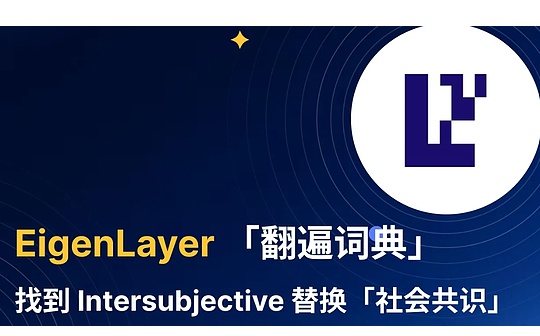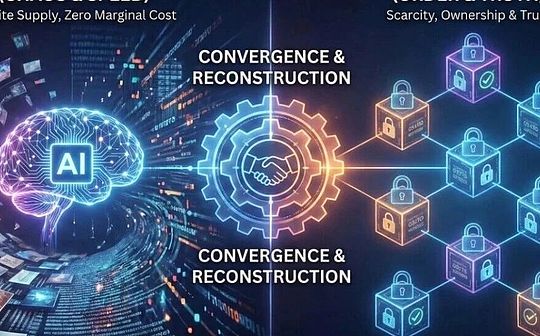
Author: ZHIXIONG PAN; Source: ChainFeeds Research
EigenLayer has just released its white paper on its protocol token, EIGEN, introducing many novel and complex concepts such as Intersubjective, Work Token, Token Forking, slashing-by-forking, and Intersubjective staking, and these terms quickly became the focus of hot discussion in the community.
The original intention of the EigenLayer protocol is to generalize the purpose of Ethereum nodes, which not only allows these nodes to execute other business logic to increase revenue, but also increase revenue for users participating in the ETH consensus.However, this adds utility to the nodes and also brings risks.Among these risks, in addition to the objective risks that can be directly observed, there are also some uncertain areas between subjective and objective.Although this uncertainty cannot be fully guaranteed through cryptography and mathematics, it is based on “social consensus”.This is exactly what is called “Intersubjective”, and I would rather translate it as “social consensus”.
And this is precisely because it is a “social consensus”, their protocol tokens need to be forked, and if they can be forked, they need to design a dual token isolation model, as well as the challenge of launching forks, etc.Logic as a supporting tool.It is more like using Ethereum to implement a complete set of network logic. It has both (social) consensus and nodes, and can also fork, but it is not a blockchain.
Apart from that, I recall some old anecdotes related to Work Token and Weak subjectivity as a supplement.
What is Work Token
Work Tokens have been discussed around 2018, and the reason why more people know is because of Kyle Samani of Multicoin Capital.In a word, under the Work Token model, service providers can only obtain the right to perform work on the network by pledging native tokens of the network.
That is, nodes need to provide tokens and services to obtain returns.Of course, with the popularity of on-chain liquidity and DeFi protocols in recent years, the tokens that nodes need to pledge can be invested through third parties, without the nodes themselves taking out a large amount of assets.This has become the current model of EigenLayer: users provide ETH, Liquid Restaking Protocol provides liquidity, node operators provide hardware, and AVS provides business logic.
In 2018 or earlier, the industry conducted various categories of tokens. The most common categories at that time were: store of value (such as Bitcoin), securities tokens, practical tokens, work tokens, etc.
Regarding Work Token and other token models, it is recommended to get started with this article by Multicoin: https://multicoin.capital/2018/02/13/new-models-utility-tokens/
What is Intersubjective?
First, let’s define two keywords: Objective and Subjective.Errors caused in blockchain and decentralized networks can be classified into the following four types according to their nature:
-
Objective errors: These errors are based on data and cryptography and can be explicitly verified, such as the execution process of an Ethereum virtual machine (EVM).
-
Intersubjective’s error: This type of error involves social consensus among groups.When certain behaviors or judgments go beyond this consensus, they are considered Intersubjective errors.
-
Unobservable errors: This type of error is only known to the victims and cannot be observed by others.
-
Subjective (subjective) errors: These errors are based entirely on personal experiences and opinions, resulting in unconsensused results.
EigenLayer believes that errors and subjective errors that cannot be observed are difficult to correct, so he proposesUse ETH to avoid objective errors, and use EIGEN to avoid Intersubjective errors.
The concept of Intersubjective can be regarded as a state between “objective” and “subjective”..The word is composed of “Inter” (meaning “between” or “mutual”, just like the “interactive” of Interactive, the “Internet” of the Internet) and Subjective (subjective).Therefore, Intersubjective refers to a subjective state formed between individuals and a consensus formed within society through interaction.
If you ask what ChatGPT Intersubjective means, it will tell you a difficult Chinese translation: “Mutual subjectivity”.
For example, in financial markets, the expression “1 BTC = 1 USD” is generally not accepted, and this erroneous consensus can be classified as an Intersubjective error.therefore,If you want to explain Intersubjective, we can understand it as a “social consensus”, that is, a shared acceptance of certain ideas or facts within a group.
Although there are subtle differences between “social consensus” and Intersubjective in academic and professional discussions—Intersubjective focuses more on describing the sharing process of subjective experience and knowledge among individuals, while “social consensus” focuses more on common decision-making andThe result of the action.
ETH objective, EIGEN subjective?
A brief review of the EigenLayer protocol, users can store ETH into the Liquid Restaking Protocol, and these protocols will pledge these ETH to run Ethereum verification nodes. These verification nodes will also run various AVS and other middleware services at the same time (such as oracles,Cross-chain bridge, data availability, etc.), providing services for terminal applications.

For AVS, it can also be divided into two types: objective and Intersubjective.Objective AVS is based on cryptography and mathematics, and can be clearly quantified and verified. In EigenLayer design, these AVSs can rely on Restaking ETH as a security guarantee.As for Intersubjective’s AVS, taking the oracle as an example, because off-chain data cannot be verified on the chain, it can only rely on social consensus between nodes. Enough data recognized by many nodes is credible.
In summary,Restaking ETH will be used as the working token for objective AVS in the EigenLayer protocol, and EIGEN will be used as the working token for Intersubjective AVS.
Can protocol tokens be forked?
Token Forking is also a novel concept.The commonly referred to as forked blockchains refers to open source code or network (that is, the chain itself), while the ERC-20 token cannot be forked in theory, at least it will not have this capability.Because tokens, as a smart contract, rely entirely on the objective properties of EVM.
But EigenLayer believes that under their framework,The forkability of tokens is a guaranteed security measure, even if it is rare in a century..If the number of malicious attackers in the EigenLayer network exceeds half, ordinary users can fork the tokens in this way, and then all users and AVS can choose the corresponding token according to their own situation. In fact, it is to let social consensusDecide which token is the most orthodox.They also call this concept slashing-by-forking (by forking) and it also originated from an article written by Vitalik Buterin 9 years ago.
In order to support this forkability, a lot of logic is needed to support it.For example, if the token is forked, can EIGEN still be used as collateral for lending agreements?Therefore, they designed a dual-token isolation model, EIGEN cannot be forked, but another type of bEIGEN can be forked.And also designed a challenge process for initiating a fork, as well as compensation logic.
Ethereum’s Weak subjectivity (weak subjectivity)
But in fact, Ethereum’s PoS consensus has long had a concept called “weak subjectivity” (invented by Vitalik Buterin again), and it is also a concept between “objective” and “subjective”.And only blockchains with PoS consensus have the attribute of Weak subjectivity.
For PoW networks, since computing power competition is a real cost, the longest chain is the safest and can be considered completely “objective”.For PoS networks, the cost of block production is negligible and the cost of attack is very low. Therefore, for nodes who have just joined the network, they need to retrieve social information and find this “weak subjectivity”. Only after joining the correct network can they participate objectivelyThe process of PoS.So there are some “subjective” factors before entering the right network.
However, for nodes that have entered the accurate consensus of Ethereum network, all consensus processes and EVM operation processes are objective, guaranteed by cryptography and mathematics, such as the determinism of EVM input and output, and double signs will beSlashing situations are also clear rules.






